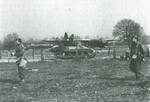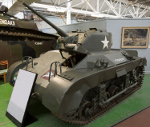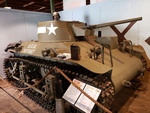M22 Locust
| Country | United States |
| Manufacturer | Marmon-Herrington Incorporated |
| Primary Role | Light Tank |
Contributor: Alan Chanter
ww2dbaseIn February 1941 the US Army issued contracts to a number of companies for a design of a light tank capable of being air portable, while the US Army Air Corps undertook to develop an aircraft in which to carry it. After considering various proposal a design by Marmon-Herrington Inc. of Indianapolis was selected as the preferred choice and an order was placed for a pilot model which was given the experimental designation of T9, Two more modified pilot vehicles (T9E1) followed in late 1942 and, after extensive testing and a number of design changes production commenced in April 1943 with an initial order for 500 machines (followed later by orders for a further 1,400). By February 1944, when production was stopped, a total of 830 vehicles had been manufactured although, by this time, the tank had been standardized as "limited standard" and given the Army designation of M22.
ww2dbasePowered by a 7,113-cc six-cylinder Lycoming air-cooled engine at the rear driving the front track sprockets through a 4-speed gearbox the 7.32-ton M22 light tank resembled a miniature M4 Sherman medium tank in general form, and used a suspension similar to that of the M3 light tank with the addition of external, strengthening rods between the bogies. The tank's layout was conventional for medium tanks of the period with the driver positioned in the hull on the front left-hand side and the other two crew members in the centrally located turret to operate the 37-mm gun and co-axial 0.30-in Browning machine gun.
ww2dbaseNo M22 light tanks were ever used by the US troops in combat and in December 1944 it was decided that there was no further requirement for an airborne light tank. Several hundred, however, were sent to the United Kingdom (where they were named Locust), where they were fitted with a Littlejohn Adaptor, converting the 37-mm to a "squeeze gun" which greatly increasing the velocity of the projectile but tended to wear out the barrels uncomfortably soon. It is not known if Locusts so equipped were used in action, although its British counterpart, the Tetrarchs light tank with Littlejohn Adaptors, certainly were.
ww2dbaseThe Locust light tanks were not greeted with any great deal of enthusiam by the British Army. A three-man crew was not generally favoured as it made command difficult. Other principle objections were that the armour was too thin (25-mm maximum), the gun too small, and the vehicle mechanically unreliable. Nevertheless, a handful were used by the 6th Airborne Division at the Rhine crossing in March 1945.
ww2dbaseThe first American plan for transporting the M22 was for the tank to be slung beneath a C-54 transport aircraft with the turret removed and stowed inside the plane. This, of course, was an impractical mode of operation, but with typical British ingenuity it was soon found that the Locust could be squeezed into a Hamilcar glider.
ww2dbaseMost M22 light tanks were scrapped soon after the war, although a few served on with the Egyptian Army through the late 1940s.
ww2dbaseSources:
B. T. White, Tanks and other Armoured Fighting Vehicles 1942-45 (Blandford Press, 1975)
Ian V Hogg & John Weeks, The Illustrated Encyclopaedia of Military Vehicles (Hamlyn, 1980)
A.J. Smithers, Rude Mechanicals (Grafton books, 1989)
Last Major Revision: Jan 2014
SPECIFICATIONS
Locust
| Machinery | One 7,113cc Lycoming O-43-T 6-cylinder horizontally-opposed air-cooled petrol engine rated at 162bhp |
| Armament | 1x37mm M6 gun (with Littlejohn Adaptor in British service), 1x0.30in co-axial Browning M1919A4 machine gun |
| Armor | 12-25mm |
| Crew | 3 |
| Length | 3.93 m |
| Width | 2.23 m |
| Height | 1.75 m |
| Weight | 7.3 t |
| Speed | 56 km/h |
| Range | 177 km |
Photographs
 |  |  |  |
Você gostou deste artigo ou achou este artigo útil? Se sim, considere nos apoiar no Patreon. Mesmo USD $1 por mês já vai longe! Obrigado. Por favor, ajude-nos a espalhar a palavra: Fique atualizado com WW2DB: |

- » Köln/Cologne Evacuated After Discovery of WW2 Bombs (4 Jun 2025)
- » US Women's Army Corps "Six Triple Eight" Awarded with Congressional Gold Medal (30 Apr 2025)
- » Wreck of Soviet Submarine M-49 Found (10 Apr 2025)
- » Japanese Emperor Visited Iwoto (Iwo Jima) (8 Apr 2025)
- » Race, Holocaust, and African-American WW2 Histories Removed from the US Naval Academy Library (7 Apr 2025)
- » US Government Plans to Purge WW2 Information (17 Mar 2025)
- » Ver todas as notícias
- » 1,171 biographies
- » 337 events
- » 44,911 timeline entries
- » 1,245 ships
- » 350 aircraft models
- » 207 vehicle models
- » 376 weapon models
- » 123 historical documents
- » 261 facilities
- » 470 book reviews
- » 28,521 photos
- » 365 maps
Fleet Admiral Chester W. Nimitz, 16 Mar 1945
Por favor, considere nos apoiar no Patreon. Mesmo R$1 por mês já faz uma grande diferença. Obrigado!
Ou, por favor, nos apoie adquirindo alguns produtos do WW2DB na TeeSpring. Obrigado!